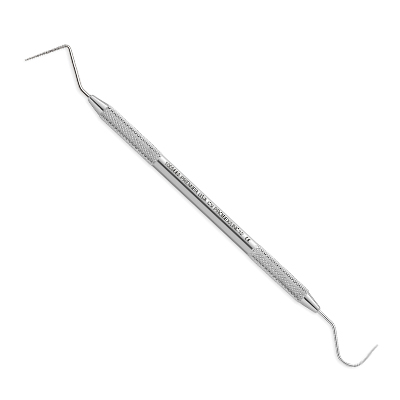Home › Forums › Periodontology › PROBING FORCE
Welcome Dear Guest
To create a new topic please register on the forums. For help contact : discussdentistry@hotmail.com
- This topic has 1 reply, 2 voices, and was last updated 15/09/2012 at 5:13 pm by
 drsushant.
drsushant.
-
AuthorPosts
-
10/04/2012 at 5:54 pm #10445
 drmithila
OfflineRegistered On: 14/05/2011Topics: 242Replies: 579Has thanked: 0 timesBeen thanked: 0 times
drmithila
OfflineRegistered On: 14/05/2011Topics: 242Replies: 579Has thanked: 0 timesBeen thanked: 0 timesProbing force can influence probing measurement and has been studied widely. Force-controlled periodontal probes have been introduced to increase the reliability of probing measurements. Van der Velden et al3 used probing forces of 0.15 N, 0.25 N, 0.5 N, and 0.75 N and found a significant difference between PPD recordings with a low and a high probing force. As a result, they recommended a probing force of 0.75 N as optimal, with probes of 0.63 mm in diameter. Chamberlain et al6 indicated that higher probing forces are more reproducible. In their study, the probe tip extended to the most coronal connective-tissue attachment in health and disease, using a force of 0.75 N. Reproducibility is important, however, because increasing PPDs or attachment-level changes may be indicative of disease activity. Reproducibility of repeated measurements has been considered a good indicator of reliability.33,39
Osborn et al34 compared the intra- and interexaminer measurement error of the Florida pocket-depth probe, the Florida disk probe, and the conventional manual probe in subjects with moderate to severe periodontitis. At the site level, the mean intraexaminer standard deviations of differences in repeated relative attachment-level measurements using the Florida disk probe and the conventional probe ranged from 0.55 mm to 0.82 mm and 0.62 mm to 1.14 mm respectively. Intraexaminer standard deviations of differences in probing depth measurements using the Florida pocket-depth probe ranged from 0.6 mm to 0.93 mm (differences in relative attachment levels for the Florida pocket-depth probe was not reported). Hassel et al40 noted a substantial variation in probing force exerted by six clinicians who probed four surfaces of 30 teeth in five patients. Moreover, they found a poor correlation between PPD measured by the probe and the probe force applied. They concluded that probing forces had only a moderate influence on the depth of measurements and that the probing technique was the more critical factor in PPD measurement than the pressure applied to the probe. Hassel et al40 reported that probing technique was important if clinical evaluations were to be correlated to the condition in reality, and favored a slow, deliberate searching style of probing for each area of the pocket. They also reported that it was the pocket topography rather than the absolute PPD that was important. Furthermore, they stated that application of heavy force is contraindicated and does not lead to greater precision.
Sites of Measurement
Persson41 compared line-angle measurements with midproximal measurements in untreated sites and found that the mean PPD was 1 mm greater with midproximal measurements than with line-angle measurements. This finding implies that clinical and epidemiologic studies using line-angle measurements may underestimate PPD and, thus, the true level of disease. From one visit to another, it is difficult to duplicate precisely the insertion force and to reproduce exactly the site and angulation of probe insertion. PPD appears to influence the reproducibility of PPD measurements, and the general consensus is that measurements of shallow pockets are more reproducible than those of deep pockets.42 Kalkwarf and Kaldahl43 determined that the pressure-controlled technique produced significantly deeper clinical probing measurements on the direct facial and lingual aspects of teeth regardless of the stage of periodontal therapy that had been completed, and manual probing obtained deeper measurements on the distolingual aspects of teeth in the posterior regions, which had not received surgical therapy. Control of vertical force during probing may provide a more objective method of monitoring periodontal status during longitudinal trials. In shallow pockets (1 mm to 3 mm) the difference was smallest, and the discrepancy increased with increasing PPD regardless of sites, stage of therapy, or location in the mouth. As well as varying by PPD, examiner reproducibility for any given method also may vary among tooth types, tooth surfaces, and PPD.39 The higher degree of reproducibility for buccal surfaces probably is explained by better visibility and by facilitated reproducibility of probe placement within the shallower pockets on these surfaces. Furthermore, in this study, access, visibility, as well as cooperation during measurements, varied between patients. Figure 6 illustrates proper probe insertion technique, highlighting possible outcomes based on variations in the angle of insertion.
15/09/2012 at 5:13 pm #15930 drsushant
OfflineRegistered On: 14/05/2011Topics: 253Replies: 277Has thanked: 0 timesBeen thanked: 0 times
drsushant
OfflineRegistered On: 14/05/2011Topics: 253Replies: 277Has thanked: 0 timesBeen thanked: 0 timesDiagnostic screening can be accomplished quickly and efficiently with the UNC 12 Probex, which contains a UNC 12 Clear-View probe tip on one end and a 23 explorer tip on the other. Clear-View periodontal probes have color-coded recessed marking that provides wear protection for long-lasting use, and their black markings contrast nicely against the stainless steel

-
AuthorPosts
- You must be logged in to reply to this topic.